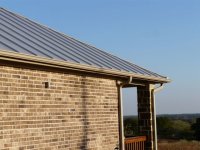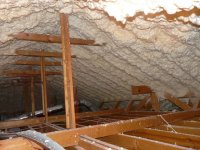eepete
Platinum Member
This might not make sense to everyone but....
I've got to go about 60 miles to get all the major stations. They are all in the same direction (I'm in Efland, NC, they are in Clayton, NC). I use a UHF 8-bay like the K7LN thumbnail for UHF. It's in the attic of my two story house. I come down on a quad shield RG-6. I also ran power to the attic and have a pre-amp up there right at the antennae. At the high UHF frequencies, the cable losses are significant and a preamp at the antennae is good. By having it all indoors, I don't have the weather issues and lightning issues, and can service things easily.
For VHF, I have a single frequency beam (for channel 11) also in the attic. It has it's own amplifier on it.
So I have a coax for UHF and a coax for VHF. In the basement, I add another gain stage to the UHF (a On-Q/Legrand VM7640 from a box store, a good amp for indoor use). These work better than the Channel Master amps (less intermodulation distortion). I mix the two signals together with an Amateur Radio 2M - 440 splitter. It has substantially less loss and better isolation than a typical UHF/VHF splitter. You plug in UHF or N to F converters on it. The impedance mismatch is negligible and insertion loss is still lower than the typical UHF/VHF device. The two ports are well isolated enough that the amplifiers driven them don't interact.
So, I think an amplifier by the UHF antennae is very important given the cable losses. My attic is conditioned space, so I don't have to worry about cooking the amplifier and can use an indoor amp. It's really nice having the attic antennae and not worrying about weather and lightning. All very unique to me situation I realize. If you can't pull what I did off, I'd at least strongly recommend an amp by the antennae and an installation where you can get to the amplifier semi-easily to change out the amplifier from time to time. Seems like the outdoor ones don't last more than a few years. I used to use a UHF amplifier in an attic that was not conditioned space (read "real hot"), it would last a year or two before it cooked and needed to be replaced. Also be sure to use the RG-6 cable.
Even if you could drop down from the attic about 10-12 feet or put an amplifier at ladder height near the base of your mast it would be a win. If it was inside then you'd have the amp on the cable where it was in nice conditioned space, then continue to the end point (basement or TV room) and you'll do better. A typical run for this sort of stuff is about 50 to 75 feet, and you'll loose a lot of signal strength in that run. If you are not sure about all this, get the amplifier and play with it (extension cords to the attic, coax down through the house, etc.) and you can see if it will work or not. Last resort is an in line amp powered by DC over the coax, but with the cable losses it can be better than nothing.
Pete
I've got to go about 60 miles to get all the major stations. They are all in the same direction (I'm in Efland, NC, they are in Clayton, NC). I use a UHF 8-bay like the K7LN thumbnail for UHF. It's in the attic of my two story house. I come down on a quad shield RG-6. I also ran power to the attic and have a pre-amp up there right at the antennae. At the high UHF frequencies, the cable losses are significant and a preamp at the antennae is good. By having it all indoors, I don't have the weather issues and lightning issues, and can service things easily.
For VHF, I have a single frequency beam (for channel 11) also in the attic. It has it's own amplifier on it.
So I have a coax for UHF and a coax for VHF. In the basement, I add another gain stage to the UHF (a On-Q/Legrand VM7640 from a box store, a good amp for indoor use). These work better than the Channel Master amps (less intermodulation distortion). I mix the two signals together with an Amateur Radio 2M - 440 splitter. It has substantially less loss and better isolation than a typical UHF/VHF splitter. You plug in UHF or N to F converters on it. The impedance mismatch is negligible and insertion loss is still lower than the typical UHF/VHF device. The two ports are well isolated enough that the amplifiers driven them don't interact.
So, I think an amplifier by the UHF antennae is very important given the cable losses. My attic is conditioned space, so I don't have to worry about cooking the amplifier and can use an indoor amp. It's really nice having the attic antennae and not worrying about weather and lightning. All very unique to me situation I realize. If you can't pull what I did off, I'd at least strongly recommend an amp by the antennae and an installation where you can get to the amplifier semi-easily to change out the amplifier from time to time. Seems like the outdoor ones don't last more than a few years. I used to use a UHF amplifier in an attic that was not conditioned space (read "real hot"), it would last a year or two before it cooked and needed to be replaced. Also be sure to use the RG-6 cable.
Even if you could drop down from the attic about 10-12 feet or put an amplifier at ladder height near the base of your mast it would be a win. If it was inside then you'd have the amp on the cable where it was in nice conditioned space, then continue to the end point (basement or TV room) and you'll do better. A typical run for this sort of stuff is about 50 to 75 feet, and you'll loose a lot of signal strength in that run. If you are not sure about all this, get the amplifier and play with it (extension cords to the attic, coax down through the house, etc.) and you can see if it will work or not. Last resort is an in line amp powered by DC over the coax, but with the cable losses it can be better than nothing.
Pete



